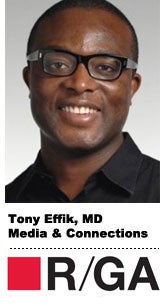 R/GA’s decision to launch a media division one year ago was an unusual step for an agency deeply associated with its creative product. The firm has always talked a good game about data, for instance using personal health data to support the award winning Nike+ and Fuel Band products. But that’s a far cry from executing media buys using first and third-party audience data and optimizing those campaigns on the fly.
R/GA’s decision to launch a media division one year ago was an unusual step for an agency deeply associated with its creative product. The firm has always talked a good game about data, for instance using personal health data to support the award winning Nike+ and Fuel Band products. But that’s a far cry from executing media buys using first and third-party audience data and optimizing those campaigns on the fly.
Tony Effik is Managing Director of Media & Connections, as the department is called. He believes a creative agency can bring something original and valuable to the online media equation. For example, he says R/GA brings a content-centric approach to media trading and to working with algorithms such as Facebook’s EdgeRank.
Effik spoke with AdExchanger about the R/GA’s unique approach to trading digital media.
What have you learned in the first year?
TONY EFFIK: Well, the first year has been fascinating, interesting, challenging and a lot of hard work. I did already have a small media practice, though. It was always in the background. There wasn’t really something that the agency had really committed to in a deep and meaningful way. The way that it was working wasn’t really working with the DNA of R/GA, which is essentially about innovation and doing stuff that other people are not doing. That was when Bob Greenberg, our chairman, decided to really ramp up on media. The brief basically was to do something different to challenge the status quo. That’s what we’ve been trying to do.
That isn’t necessarily an easy thing to do. There are a lot of smart, hard‑working people out there already in the business. Coming up with that unique way of looking at the market took a little while, but we’re starting to get there. I’m not saying we’re completely there yet, but we’re a good distance into our value proposition.
How would you describe the value proposition?
It’s the fact we’re an integrated shop. If you hearken back to the time before the ’90s, when media was spun off and unbundled from the creative agencies, we’re right back there, first of all. We’re combining creativity and media. And we’re going to a place they didn’t hit pre‑1990. There are some times when the media idea is the creative idea, and the creative idea mostly drives the media idea, and I think just by having people in one place, it’s just the first step. The second step is creating processes and mechanisms to ensure that you actually do something different.
Part of that difference comes from dividing the market and what we do into two very distinct groups of things. One we call hand crafted, which is about premium inventory — premium partnerships, if you like. For example, we work with Food Network but we don’t just say, “How many impressions can you give us?” We’re interested in is their talent as well. Because, their talent is really second to none in connecting to people out there interested in recipes and food. What we’re trying to do in these hand-crafted buys is to team up our talent, our creativity, with their talent.
The other space is automated marketing, pragmatic buying, and the world of algorithms. We’re really deep in to that world as well. We were a little bit slow off the bat as an agency into that space, but in the last few months we’re thriving off that path of business. We got a relationship now with Invite [DoubleClick Bid Manager]. We’ve always had deep relationships with Google, and Facebook as well.
On programmatic strategy…
When we go in to these exchanges we are thinking about a couple of things. One is what we call a trading strategy. We have these trading strategies, which are very competitive. We are looking at what everybody else is doing because there are patterns in every category. For example, we see in the recipe market, in the financial market, in all sorts of markets, there’s a very distinct ways people go to market.
We feel that part of the core competency going forward is being able to decode these markets so you can zig when everyone else is zagging — because you’ve got a great big visualization team. When you understand what that code it for each category, you can start guessing your competitive advantage. So that’s the first part. That’s the trading strategy side.
The other side is algorithms. That’s a big thing for us. There’s a whole industry of SEOs if you like on Google search. But few people really take into consideration how the EdgeRank algorithm works on Facebook.. We spend a lot of time on the Facebook one around how you combine own and paid media from Facebook. What posts do you invest in? How much do you invest? Who do you target?
I have a friend at Facebook, he says, “It sounds like you’re trying to game my algorithm.” I say, “If I’m investing significant dollars in Facebook, I want to know how it works. You don’t publish the details. I’m not going to invest blindly with you guys. I want to know if I do X, I’m going to get Y.”
Algorithms also inform in respect to the optimization as well. If you’re running multiple ads in multiple places with multiple messages and all sorts of stuff, you get your results back but you’ve got to smart about once you get the data. What do you do about it? Even when we are doing the hand crafted stuff, data is at the center of that.
Do you think there’s a rising opportunity for creative agencies to play in media?
Yeah, absolutely. [Agencies decoupled media from creative] because they could concentrate buying power. They could do these huge deals. They’ve got a little more leverage against the publisher, in particular against the networks, because it was previously about television. They’d go out on the golf course and have lunches until everyone was happy.
But…the future of buying power isn’t how much money you’ve got in the bank but what your data is, yeah? There is an opportunity for a creative agency. It’s not just the fact that you can bid in the auction… Audience begets content. That is the other side of it. It’s ensuring people are getting the right content at the right time. We see an evolution of that as well.
Are you working through Mediabrands Audience Platform on your trading or you managing it in-house?
In the end, we move around. We work very closely with Mediabrands, we purchase together. But we also have some starter relationships with people at Invite [DoubleClick Bid Manager] as well.
Follow Tony Effik (@aeffik) and AdExchanger (@adexchanger) on Twitter.











